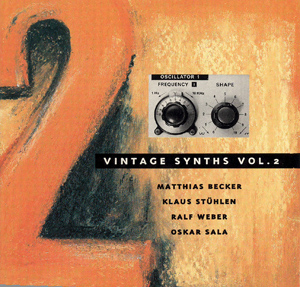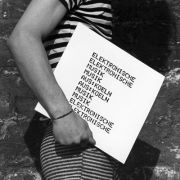
VINTAGE SYNTHS Vol.2
Matthias Becker, Klaus Stühlen, Ralf Weber and Oscar Sala
1. Roland Jupiter 6 (3:08)
Roland's Jupiter 6 was one of the first analog synthesizers provided with the MIDI interface. Though the instrument's bass sounds are not quite as convincing as those of its "big brother" the Jupiter 8, its multimode filter an its comprehensive modulation section make it a very capable machine with a unique sonic character.
_2. Korg Sigma (3:18)
Though because of its design often mistaken for a preset instrument only suited for for dance musicians the Korg Sigma nevertheless is a very interesting analog synth. Despite the fact that the instrument is only monophonic you can achieve lots of very thick and interesting textures
by layering different sounds. For the lack of any midification this track was played by hand.
3. ARP 2600 (1:43)
The sounds to be heard here are just a tiny little part of the sonic palette of this classic synth because the accent of the composition lies on the gradually shifting of the rhythm rather than on the change of timbre.
4. OSC Oscar (2:19)
This instrument because of its digital waveforms and its multimode filter offers quite a unique sonic character. The separate voices and parts of this fugue were each realized with different sounds and were recorded with the aid of MIDI and computer.
5. Oberheim OB-XA Part 1 (3:37)
The brass and string sounds of this take clearly point out why the OB-XA is one of the great vintage polyphonic synths. The instrument used was not equipped with MIDI but the percussion sounds were put into place via sampling.
6. Roland System 700 (3:28)
Together with the Moog Modular System the Roland System 700 surely is one of the most popular big modular systems ever built. For recording this track we did not make use of a complete system but of a so called LABORATORY UNIT which in regard to its components is very similar to a minimoog. The sound of the System 700 got a bit more punch and power than this of the Roland 100M system. Recorded with the aid of computer and Roland MPU-101 Interface.
7. SCI Prophet 5 (2:26)
Though also one of the great vintage analog synths the Prophet 5 in matters of sound differs a lot from the OB-XA. Because our instrument was not equipped with MIDI the track was played by hand. Only the percussion sounds were triggered as "one shot samples" via MIDI.
8. Fairlight CMI-2X (3:44)
This take was realized nearly completely by using original Samples of the Fairlight's library (SARRAR, SWANEE, CHOIR 5, CAMILLA etc.). Only the surf is not a factory sample but was recorded at the beach of Kokkari (Isle of Samos&Mac218; Greece). The hiss to be heard is the
result of the Fairlight's vintage 8-Bit resolution.
9. Mixturtrautonium:
Caprice für Mixturtrautonium Solo (4:32)
This take is the only one presented here which was recorded totally live without any additional overdubs. Sala who is the only virtuoso on this rare instrument the MIXTURTRAUTONIUM which produces its sounds on the basis of subharmonics and is played via two fingerboards (or
tonebands) describes his piece as follows. "CAPRICE NO.4 FÜR MIXTURTRAUTONIUM SOLO offers a new routing of the reverb for the solo voice on the upper fingerboard by which is achieved that the solo voice always stays in the foreground though there is a strong reverberation effect to be heard while chords played on the lower fingerboard are supplied with a pure harmonic reverb. In order to achieve this the 2 reverberation units, 2 delays and 2 harmonizers are routed as follows: reverberation unit 1 supplys the solo voice with the simulation of a small hall. Connected in parallel to this one are 2 combinations consisting of one delay and one harmonizer connected in series, which are fed with the simulation of a large hall from reverberation unit 2. The delay time of the delay units is about 60 ms and the two harmonizers are tuned to unisono and a major third above. The second harmonizer can also supply echo effects via the mixing console. The amplitudes of the harmonizers can be changed at the mixing console in real time while playing. Independantly from this also the solo timbre in this CAPRICE is changed between two formants while playing. The harmonic accompaniment consists of a subharmonic bass, a subharmonic mixture for the middle registers and a subharmonic mixture that lies one octave higher. They are controlled by horizontal movements of the footpedals
and also routed to reverb 2 but do not interfere with the combinations. In the horizontal movements of the pedals a useful physiological symmetry was found: both pedals to the right activates the higher registers, both pedals to the left calls up the lower registers and both in the middle selects the middle registers. Though one could also do it in a completely different way from the way I do, I sucessfully used this symmetrical system since 1935. In the CAPRICE I demonstrate how the leathercovered dummy keys above the fingerboards are located in a way
that makes it possible to realize glissandi and portamenti in any register and into any direction. The sounds controlled by the two fingerboards are spread over the stereophonic image. The sounds of the first fingerboard you will hear a bit more on the left, those of the second fingerboard a bit more on the right.
10. Roland System 100M (2:42)
For the recording of this composition we made use of 4 racks with 5 modules each. This awfull lot of oscillators, filters VCAs etc. made it possible to achieve the rich textures to be heard here. Complex modulations of pitch and timbre give a good idea of the sonic capabilities of a large modular system. Recorded with computer and Roland MPU-101.
11. Oberheim OB-XA Part 2 (2:24)
This take demonstrates that the synths built by Oberheim already offered complex modulation possibilities before thr release of instruments like the EXPANDER or the MATRIX 12. You will hear persuading simulations of strings and brass and in the solo part a sync sound which you normally would expect from a Prophet 5 rather an OB- XA.
12. Roland Promars (1:59)
That not only Moog is able to sound like Moog proves the little Roland Promars with this invention which in parts reminds us of the sounds first made famous by pioneer Wendy Carlos on SWITCHED ON BACH. Correct timing thanks to computer and MIDI- interface.
13. DK Synergy I (2:39)
At first glance the Synergy 1 seems to be very restricted in matters of sound with its 24 onboard presets which offer only tweaking but cannot be changed radically. But as soon as you dive deeper into the secrets of this machine you realize that there is a lot to get out of it if you treat this instrument right. Because of its totally digital soundgeneration the Synergy sounds rather different from most of the other vintage synths presented on this CD. Handmade.
14. ARP Pro Soloist (2:23)
This take proves that even with a small preset synth it is possible to realize complex compositions. We made extensive use of the touch sensitivity feature of the keyboard. No computer, no MIDI.
15. EMS Synthi 100 (2:36)
As large as a cupboard this synth is by any means one of the largest synths ever build. Because the tuning stability of its oscillators is very poor, it is suited more for the generation of soundeffects and the processing of sounds than the realisation of harmonically complex
compositions. The sequenzes were made by linking the beast with two analog sequencers (ARP and KORG SQ- 10) for the control of timbre and pitch.
16. Advanced Memorymoog (3:15)
The Memorymoog is featured on this CD again because its possibilities have been largely increased by the LINTRONIC interface developped by Rudi Linhart. The ADVANCED MEMORYMOOG offers excellent tuning stability, can by controlled dynamically and its sounds can be edited via MIDI.
17. Korg EX-8000 (4:13)
We included this in comparison to the other synths featured on this album rather young instrument because we believe it to be a very powerful machine. 'Cause all of its parameters are controllable via MIDI system exclusive data in realtime it is very well suited for the dynamic
control of timbre.
18. Roland JX-10 (3:12)
Roland's former main-axe persuades the listener by its lush strings, its realistic brass sounds and its very clean, yet warm sound.
19. RSF Kobol (2:33)
This 19"- expander made in France is a weird little monster because of such rare features as voltage controllable envelopes, voltage controllable waveshapes and voltage controllable filter resonation. The strange vocal sound was achieved by using a TALKING PEDAL by Electro
Harmonix. The take features a composition that we already used on our first CD to introduce the Moog 55 and the ARP Odyssey. Recorded with the aid of computer and MIDI.
20. EDP WASP (3:10)
Chris Huggett's tiny black-yellow plastic synth is perfect when it comes to generate sizzles, blurbs or squeeks of any kind. Handmade.
Credits:
Composers: Klaus Stühlen: tracks 2, 3, 5, 11, 14, 18 Ralf Weber: tracks 1, 4, 7, 13, 17 Matthias Becker: tracks 8, 15, 20 Oscar Sala: track 9 K. Stƒhlen&Mac218; M. Becker: tracks 6, 10, 12, 16 R. Weber/ K. Stühlen/ M. Becker: track 19_© Caprice No.4 für Mixturtrautonium Solo: Erdenklang Musikverlag_Recording and Mixdown:_ORIGINALTON WEST STUDIO/ Cologne UPTOWN STUDIO/Cologne STUDIO
OSCAR SALA/ Berlin STUDIO KLAUS STÜHLEN/ Cologne_Editing for Compact Disc: John Cremer/ EMI MUSIC OPERATIONS COLOGNE _Layout: Andrea Küffner_Photographs: Dieter Stork, Matthias
Becker_Produced by Matthias Becker_© ORIGINALTON WEST
1992__We would like to thank all those who contributed to the realization of this CD. Our special thanks go to: Hans Faºbender (MUSIC CITY/ Cologne) for the restauration of several of our vintage synths, Rudi Linhart (LINTRONICS/ Nürnberg) for the development of the
ADVANCED MEMORYMOOG, Bob Moog und Wendy Carlos for having started it all and Wolfang Düren (TSI/ Waldorf), Dirk Matten and Achim Lenzgen (SYNTHESIZERSTUDIO BONN), Bob Williams (St. Austell/ Cornwall), Ludwig Rehberg (EMS/ Ditzingen), Ulrich Rützel
(ERDENKLANG Musikverlag) and - of course - Oscar Sala.
